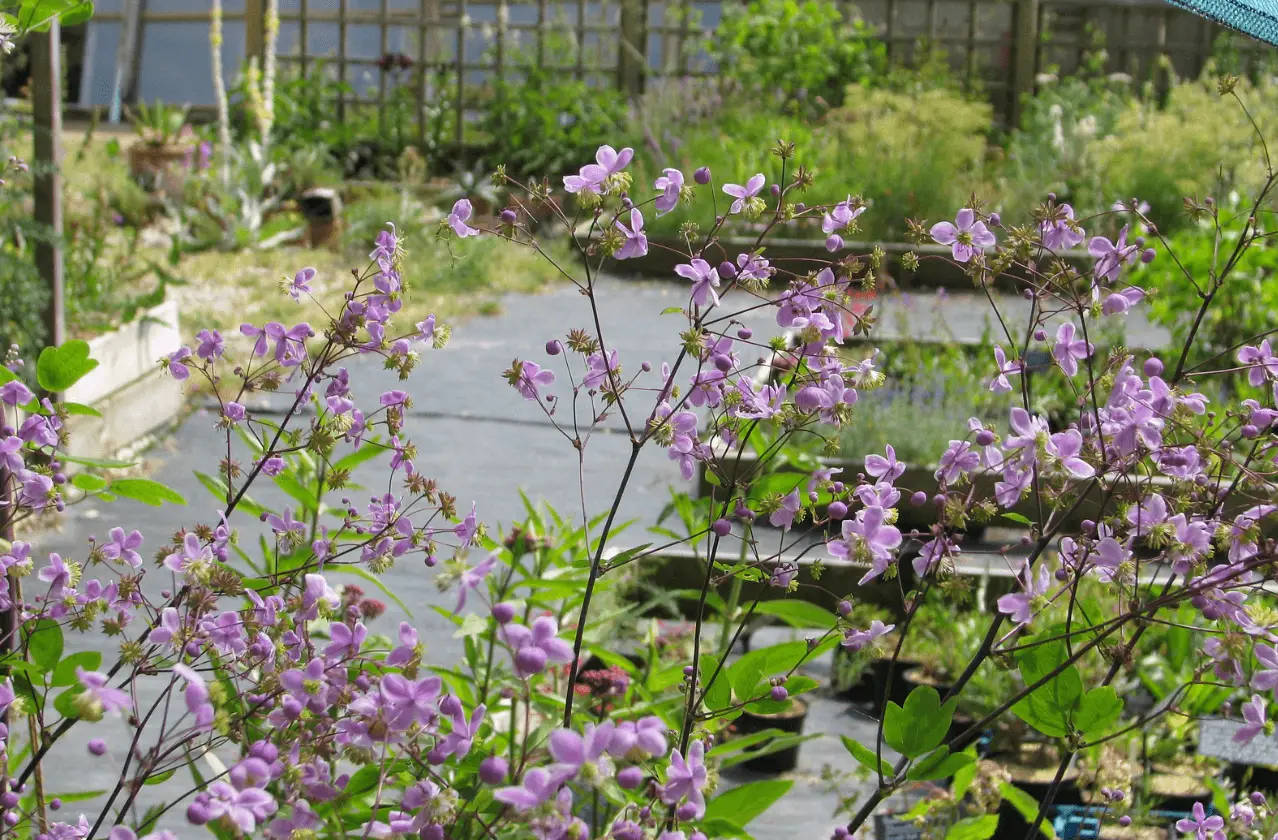Thalictrum delavayi: Growing and Care Guide

If you’ve stumbled across the enchanting world of Thalictrum delavayi, or Chinese meadow rue then it’s time to discover how to grow and care for this garden delight.
This elegant, perennial plant brings a touch of grace and charm to any garden with its fluffy small flowers that make it perfect for a late or mid-summer cut flower arrangement.
In this blog, we’ll delve into the art of cultivating and caring for Thalictrum delavayi, sharing our tips and tricks to ensure your garden flourishes with a rich show of thalictrum flowers through summer and early autumn.
Choosing the Perfect Spot for Your Thalictrum Delavayi
Finding the ideal location for your Thalictrum delavayi is crucial for its growth and overall health. To ensure your plant thrives, consider the following factors when selecting the perfect spot:
Sun or Part Shade
Thalictrum delavayi grows well in a range of light conditions, making it quite versatile. In cooler regions, it can tolerate full sun, while in warmer areas, dappled shade or part shade is preferred. Providing your plant with the right amount of light will encourage strong growth and an abundance of blooms.
Soil Types
Thalictrum delavayi is adaptable to various soil types but has a clear preference for specific conditions. The ideal soil for this elegant perennial is moist, well drained soils, and rich in organic matter. Here’s a breakdown of the preferred soil types:
Loam
This plant thrives in loamy soil, which offers the perfect balance of clay, silt, and sand particles. Loam provides excellent drainage, aeration, and nutrient retention, ensuring your Thalictrum delavayi receives the essential elements it needs – if you don’t have a free flowing yet moist soil, then consider adding in sand and grit, as well as a good mulch.
Clay Soil
Thalictrum delavayi can also grow in clay-loam soil, which has a higher proportion of clay particles. Clay-loam offers improved moisture retention, making it suitable for plants that require consistent moisture. However, it’s essential to ensure that the soil drains well to prevent waterlogging, as with many plants, a waterlogged root system may succumb to rot and kill your plant.
Organic-rich
Soil rich in organic humus, or decomposed organic matter, is highly beneficial for Thalictrum delavayi. Organic matter enhances soil structure, water retention, and nutrient availability, promoting healthy plant growth. Incorporate well-rotted compost or leaf mould into the soil to increase its content.
When selecting the perfect spot for your Thalictrum delavayi, ensure it is sheltered from strong winds. The plant’s slender stems can be easily damaged by harsh gusts, so a more protected location is preferable.
By carefully considering the sun or partial shade conditions and soil types, you can create an environment where your Thalictrum delavayi will flourish. This attention to detail will reward you with a stunning display of delicate, lacy foliage and enchanting, cloud-like blooms that elevate your garden’s beauty.
Planting Thalictrum Delavayi: The Right Time and Method
The best time to plant is in the spring or autumn. Ensure you space them about 60cm (24 inches) apart to allow for proper growth. Dig a hole twice the width of the root ball and deep enough to accommodate the plant’s roots. Mix in some organic matter, such as well-rotted compost or leaf mould, to enrich the soil. Place the plant in the hole, ensuring the crown sits just above soil level, then backfill and water thoroughly.
Caring for Your Thalictrum Delavayi
Watering
Thalictrum delavayi requires consistent moisture, especially during dry spells. Water regularly during the growing season, ensuring the soil remains moist but not waterlogged so as to avoid rot.
Feeding
Apply a balanced, slow-release fertiliser in early spring to encourage healthy growth. Top-dress the plant with organic matter, such as well-rotted compost or leaf mould, to maintain soil fertility – mulching like this will ensure nutrients and water retention.
Pruning
Prune the plant after flowering, cutting back the spent flower stems to the ground. This will encourage fresh foliage growth and maintain a tidy appearance, you can also take regular cuttings as the plant makes for perfect cut flower arrangements.
Pest and Disease Control
Thalictrum delavayi is relatively pest-resistant. However, watch for signs of aphids, slugs, or snails, which can occasionally cause damage. Use one of our many natural slug repellent suggestions if you find your plant being nibbled or even try a handy copper scourer around the base to keep them away.
Propagating Thalictrum Delavayi
It’s relatively easy to propagate this flower by seed or division. Sow seeds in autumn, barely covering them with soil, and provide a cold frame for protection during winter. Alternatively, divide established clumps in spring or autumn, ensuring each division has a healthy root system and at least one growing point.
Conclusion
Thalictrum delavayi is a graceful, elegant addition to any UK garden. With proper care and attention, this Chinese meadow rue will reward you with a stunning display of delicate, lacy foliage and charming, cloud-like blooms. Follow our tips for cultivating and caring for Thalictrum delavayi, and you’ll soon have a thriving, beautiful garden that’s the envy of your neighbourhood.





